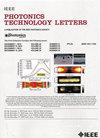High Performance ZnO CQDs/MoSe₂ Heterojunction UV-Visible Broadband Photodetector
IF 2.3
3区 工程技术
Q2 ENGINEERING, ELECTRICAL & ELECTRONIC
引用次数: 0
Abstract
This letter reports an ITO/n-ZnO CQDs/n-MoSe2/Ag structure based ultraviolet-visible (UV-Vis) broadband photodetector where the n-n heterojunction between ZnO colloidal quantum dots (CQDs) and MoSe2 thin film fabricated on an Indium tin oxide (ITO) coated glass substrate forms the active region of the device. The ZnO CQDs synthesized by hot-injection method was spin-coated on the substrate while MoSe2 nano-powder synthesized by hydrothermal method was deposited on the ZnO CQDs layer by thermal evaporation method to obtain the ZnO CQDs/MoSe2 heterojunction. The heterojunction showed a broad absorption spectrum covering the UV-Vis region. Under applied bias voltage of 2 V, the proposed photodetector showed the maximum responsivity (R) of ~282 A/W, detectivity (D) of高性能ZnO CQDs/MoSe₂异质结紫外可见宽带光电探测器
本文报道了一种基于ITO/n-ZnO CQDs/n-MoSe2/Ag结构的紫外可见(UV-Vis)宽带光电探测器,其中ZnO胶体量子点(CQDs)和MoSe2薄膜之间的n-n异质结在氧化铟锡(ITO)涂层的玻璃衬底上形成器件的有源区。将热注入法合成的ZnO CQDs自旋涂覆在衬底上,将水热法合成的MoSe2纳米粉末通过热蒸发法沉积在ZnO CQDs层上,得到ZnO CQDs/MoSe2异质结。异质结具有较宽的紫外-可见吸收光谱。在施加2 V偏置电压下,光电探测器的最大响应度R为282 A/W,探测率D为$\sim 9\times 10 ^{12}$ Jones,外量子效率EQE为90000% at 380 nm (with $47~\mu $ W/cm2 intensity) in the UV region whereas R ~16.15 A/W, D $\sim ~5.37\times 10 ^{11}$ Jones, EQE ~3660% were measured at 550 nm (with 0.22 mW/cm2 intensity) in the visible region. The transient response analysis of the device showed a rise time (fall time) as 7.25 sec (2.25 sec) at 380 nm and 1.2 sec (2.2 sec) at 550 nm.
本文章由计算机程序翻译,如有差异,请以英文原文为准。
求助全文
约1分钟内获得全文
求助全文
来源期刊

IEEE Photonics Technology Letters
工程技术-工程:电子与电气
CiteScore
5.00
自引率
3.80%
发文量
404
审稿时长
2.0 months
期刊介绍:
IEEE Photonics Technology Letters addresses all aspects of the IEEE Photonics Society Constitutional Field of Interest with emphasis on photonic/lightwave components and applications, laser physics and systems and laser/electro-optics technology. Examples of subject areas for the above areas of concentration are integrated optic and optoelectronic devices, high-power laser arrays (e.g. diode, CO2), free electron lasers, solid, state lasers, laser materials'' interactions and femtosecond laser techniques. The letters journal publishes engineering, applied physics and physics oriented papers. Emphasis is on rapid publication of timely manuscripts. A goal is to provide a focal point of quality engineering-oriented papers in the electro-optics field not found in other rapid-publication journals.
 求助内容:
求助内容: 应助结果提醒方式:
应助结果提醒方式:


